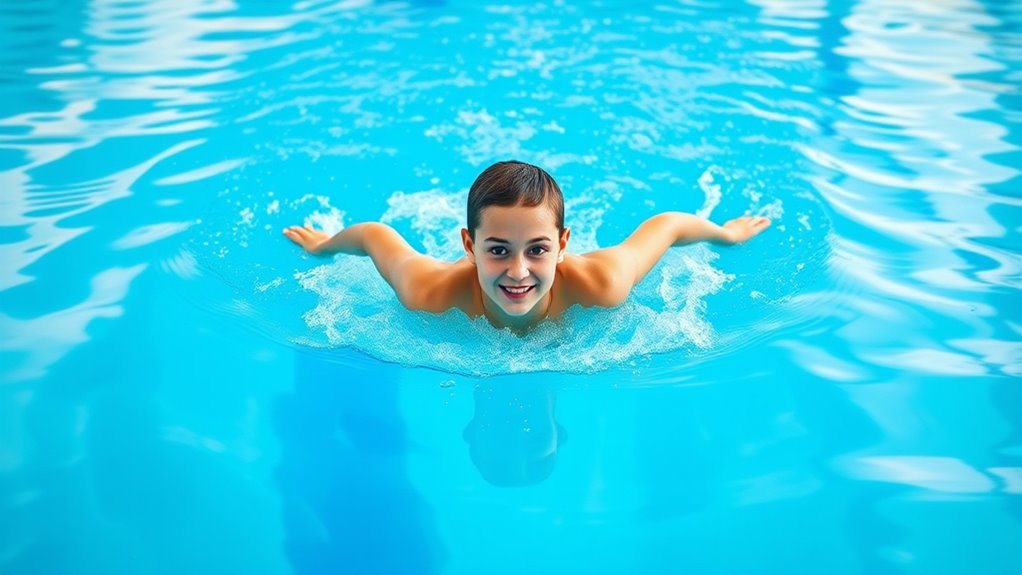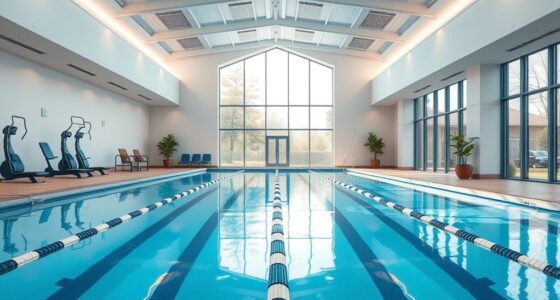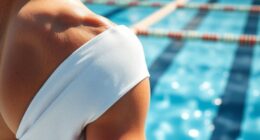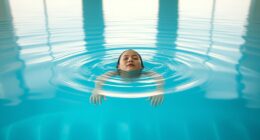To improve your lap swimming stroke, focus on steady breathing, ideally using bilateral breathing to balance your technique and reduce fatigue. Keep your kick relaxed and powerful from your hips, maintaining good body alignment. Coordinate your breathing, kicking, and arm movements for smooth, efficient strokes. Practice drills to build strength and muscle memory, and stay consistent with your technique. Mastering these basics will help you swim smarter and more confidently—stick with it, and you’ll find even more ways to refine your skill.
Key Takeaways
- Focus on proper breathing by inhaling bilaterally every three strokes to develop balance and efficiency.
- Keep legs relaxed and use hip-driven kicks to maintain body position and reduce drag.
- Practice drills that isolate breathing and kicking to build muscle memory and coordination.
- Maintain steady, synchronized movements of arms, legs, and breathing for smooth, efficient strokes.
- Develop consistency through regular practice to enhance endurance, technique, and overall swimming efficiency.

Are you looking to improve your lap swimming skills and make your workouts more efficient? One of the key areas to focus on is your breathing patterns. Proper breathing isn’t just about inhaling and exhaling; it’s about integrating it smoothly into your stroke to maintain rhythm and conserve energy. Start by practicing bilateral breathing, which involves inhaling every three strokes. This helps you develop a balanced stroke and improves your ability to breathe comfortably on both sides. When you swim, turn your head to the side just enough to breathe without lifting it too much, which can cause drag and disrupt your body position. Exhale steadily underwater, so when you turn to breathe, you only need to inhale quickly. Developing consistent breathing patterns reduces fatigue and allows you to swim longer distances with less effort. Consistent GMC tuning can also help optimize your overall swimming efficiency by fine-tuning your technique and performance.
Another critical aspect of improving your stroke is mastering kick techniques. Your kick provides propulsion and stability, so a strong, efficient kick can markedly enhance your overall swim. Focus on keeping your legs relatively straight but relaxed, with a slight bend at the knees. Use your hips to generate power rather than just your ankles; imagine your legs as pendulums swinging from your hips. When practicing kick techniques, try kicking from your hips rather than your knees, which helps create a more streamlined and powerful movement. Keep your ankles flexible and relaxed to maximize the effectiveness of each kick. Incorporate different kick drills, like flutter kicks or dolphin kicks, into your routine to build strength and improve your kicking rhythm. Remember, a strong kick also helps maintain body position, reducing drag and making your strokes more efficient.
Integrating these elements—breathing patterns and kick techniques—into your training requires mindfulness and consistency. Focus on maintaining a steady rhythm, not rushing your breathing or kick, but syncing them smoothly with your arm movements. As you become more comfortable, your strokes will feel more natural and effortless, and your endurance will improve. Keep practicing drills that isolate these techniques, like kick sets or breathing exercises, to enhance your muscle memory and coordination. Over time, you’ll notice your lap times improve, your energy levels stay higher throughout your workout, and your overall swimming becomes more fluid and enjoyable. Remember, the goal isn’t just to swim faster but to swim smarter, using proper breathing and kicking techniques to maximize your efficiency in the water.
Frequently Asked Questions
How Can I Stay Motivated to Swim Regularly?
To stay motivated to swim regularly, you should set specific goals that excite you and keep you focused. Track your progress to see how much you’ve improved, which boosts your motivation. Celebrate small victories along the way, and mix up your routine to prevent boredom. Remember, consistency is key, so make swimming a part of your schedule and remind yourself of the benefits to stay committed.
What Are Common Mistakes Beginners Make in Lap Swimming?
Imagine your swim as a dance, but some beginners trip over their own feet. Common mistakes include breathing errors, which disrupt your rhythm like a sudden gust of wind, and kick inconsistencies, causing uneven propulsion. You might find yourself gasping for air or wasting energy. To improve, focus on steady breathing and consistent kicks, transforming your stroke into a smooth, flowing movement rather than a stumble through water.
How Do I Choose the Right Swim Goggles?
When choosing swim goggles, focus on Goggle Fit to guarantee comfort and a secure seal, preventing leaks. Consider Lens Types based on your needs—clear lenses for indoor swimming, tinted for outdoor, or mirrored for bright conditions. Try on different styles to find the best fit, and make sure they don’t pinch or leave marks. Comfortable, well-fitting goggles improve your swim experience and help you stay focused on your technique.
What Should I Do if I Experience Cramps During Swimming?
Did you know that muscle cramps affect up to 70% of swimmers? If you cramp during swimming, focus on muscle relaxation by gently stretching the affected area. Make sure your electrolyte balance is maintained through proper hydration and nutrition. Slow down your pace to prevent fatigue, and consider incorporating magnesium-rich foods. Listening to your body and addressing cramps promptly helps you stay comfortable and improve your overall swimming experience.
How Can I Improve My Breathing Technique While Swimming?
To improve your breathing technique while swimming, focus on maintaining a steady breathing rhythm that matches your stroke pace. Practice exhalation techniques by fully blowing out air underwater, which makes inhaling easier and quicker when you turn your head. Consistent practice helps you develop a natural rhythm, reducing fatigue and increasing efficiency. Remember, controlled breathing keeps you relaxed and helps you swim longer with less effort.
Conclusion
Mastering these lap swimming techniques will transform you into a swimming superstar faster than you can say “Olympic champion.” With consistent practice, you’ll glide through the water so effortlessly, it’ll feel like you’re flying. Your strokes will become so smooth and powerful, they’ll make dolphins jealous. Keep at it, and you’ll not only improve your fitness but also become a legend in your own swimming pool. Get ready to leave all other swimmers in your wake—literally!









